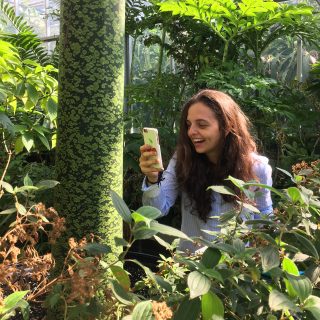#plantlove: Cecilia Zumajo, Ph.D. student
Posted in People on March 18 2019, by Plant Talk
As part of #plantlove at NYBG, we’re talking with people from all over the Garden about what inspires their passion for plants. Today, meet Cecilia Zumajo, Ph.D. student at the Garden.
 My Name is Cecilia Zumajo, and I am a Ph.D. student here at the Garden. I’m studying plant evolution and development, specifically seed ovules and seed development in gymnosperms. I grew up in Colombia, and growing up in a neo-tropical country exposed me to the enormous diversity of flowers and fruits, in terms of shapes, colors, textures—everything! So I started looking at fruits specifically, and all of the genetics underlying the diversity of fruits.
My Name is Cecilia Zumajo, and I am a Ph.D. student here at the Garden. I’m studying plant evolution and development, specifically seed ovules and seed development in gymnosperms. I grew up in Colombia, and growing up in a neo-tropical country exposed me to the enormous diversity of flowers and fruits, in terms of shapes, colors, textures—everything! So I started looking at fruits specifically, and all of the genetics underlying the diversity of fruits.
When I came here, the landscape was so very different. Mostly gymnosperms, such as pine trees, ginkgo, all of those. I started looking at them differently because in Colombia I didn’t like gymnosperms at all. For me, they were an invasive thing—we actually have a lot of zamias and cycads originally from Colombia, which are great, but we also cultivate a lot of pine trees for wood. I only knew the pine forest, which impacted the soil by making it more acidic. After the pines, nothing else would grow in that spot.
In New York, most of the green you see in winter is provided by gymnosperms, so for me it was a big change. I think that’s what triggered my interest in gymnosperms, rather than distaste. I also started looking at the reproductive structures—when you look at the seeds of these trees, you realize they don’t have fruits! These species developed a completely different strategy to disperse seeds compared to the plants I knew back in Colombia. In my studies, I came to look at all of these structures surrounding the gymnosperm seeds, not fruits yet equally effective.
I like to walk through the Benenson Ornamental Conifers while I’m at the Garden, observing these trees. They are each quite different—the architecture, the different bark patterns, the leaf colors. Each is unique. It’s amazing how you can learn to appreciate a plant in its native environment, seeing how it thrives.

